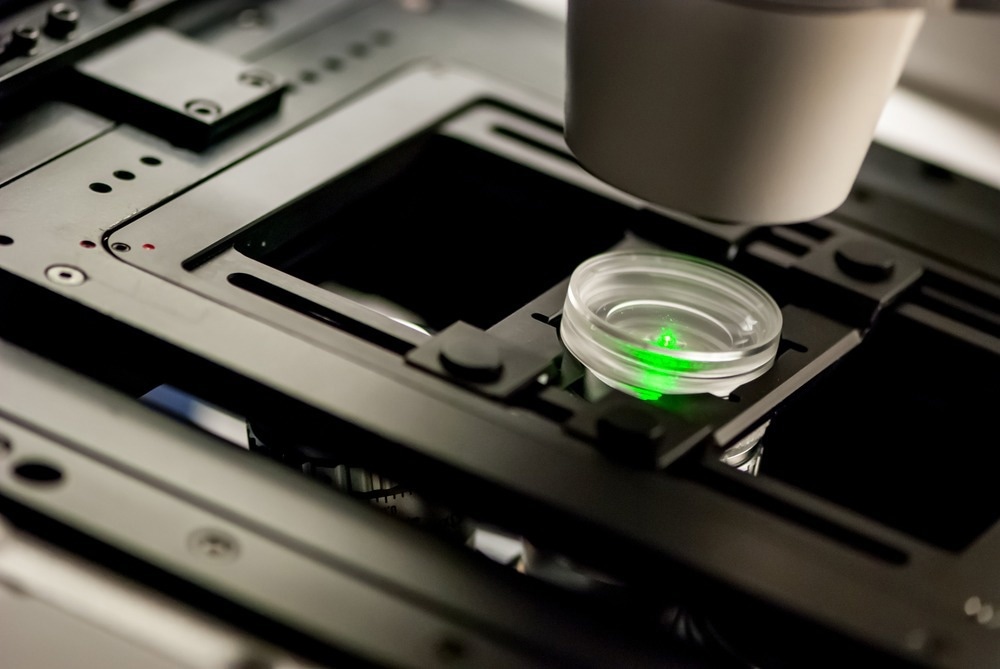Research has led to the possibility of producing lasers that involve biological cells, opening up a new avenue of exploration in biophotonics, the field of cellular lasers and biolasers.

Image Credit: Micha Weber/Shutterstock.com
Many significant advances have been made in the newly emerging fields of cellular lasers and biolasers. These developments have led to many potential applications in in vitro and in vivo cell imaging. Lasers have much promise in facilitating breakthroughs in medical science and biology by enhancing the study of biological and biophysical phenomena.
Important advances include steps forward in biosensing, cancer cell imaging, laser-emission-based microscopy, cell tracking, cell distinction study, and contraction monitoring (demonstrated in zebrafish).
Cellular lasers are a promising emerging tool for the study of a plethora of biological and biophysical phenomena. They could enable significant breakthroughs and even paradigm shifts by furthering our knowledge of how living things function.
The Development of Cellular Lasers
Cellular lasers involve biological systems in the lasing system. The idea behind the development of these lasers is that signals cells that express a fluorescent protein when placed inside an optical cavity generate amplified stimulated emission upon sufficient optical pumping.
This was demonstrated for the first time by researchers Gather and Yun, who created an in vitro cellular laser with the placement of a single-enhanced green fluorescent protein (expressing 293ETN) cell into an external high-Q resonator - consisting of two distributed Bragg reflectors.
They then expanded on this by incorporating E.coli bacteria that had been programmed to produce the green fluorescent protein within a Fabry–Pérot type cavity. They demonstrated that once the system had been pumped at energies superior to the lasing threshold, a narrow linewidth emission signal was detectable.
The scientists then showed that staining the cells with organic fluorophores could replace the role of fluorescent proteins by acting as a gain medium. Gather and Yun also showed a wide range of organic fluorescent dyes that are frequently employed in cell stainings, such as fluorescein, FITC-Dextran, Calcein-AM, and rhodamine 6G, could successfully be used to induce stimulated emission. Their research studied numerous types of cell lines, including HeLa, NIH3T3, HEK293, EL4, and red blood cells.
The results of this research concluded that lasing modes were highly sensitive to cell properties, and, therefore, demonstrated the possibility for cellular lasing technology to be developed for the characterization, sorting, and sensing of cells.
Applications of Cellular Lasers in the Study of Biological and Biophysical Phenomena
Since their development, research with cellular lasers has grown their use in several applications within biochemical analysis, biosensing, cell classification, and cell imaging.
The use of cellular lasers has numerous advantages, including enhancing resolution and improving the sensitivity of microscopic cell imaging. They can also improve the brightness of signals in comparison with fluorescence emission, allowing for the generation of higher contrast images, helping scientists to better interpret images, and overcoming issues surrounding depth penetration when imaging thick biological samples.
In the coming years, it is expected that developments in imaging techniques will be based on stimulated emission. Cellular laser technology will help to develop more efficient flow cytometry.
Cellular laser technology differs from fluorescence, for which the change of emission property is not apparent. Laser emission, on the other hand, is highly sensitive to small changes in a cell’s optical properties. This is beneficial for the development of distinction applications of cellular lasers, as cells have very distinct intracellular refractive indices directly related to cell compartments and types.
At this point, only very few applications of cellular lasers have been exhibited, although many more have been theorized and will likely come to fruition in the coming years.
The first application that has been demonstrated is the use of cellular lasers in detecting levels of sodium chloride (NaCl) within cells. This is important because NaCl is vital for neuronal signaling as it moderates membrane potentials and regulates the excitability of neurons.
Secondly, cellular lasers have been used to identify and track individual migrating cells due to the lasing spectrum of individual cells that can give them a barcode-type label.
Another application that has recently emerged is that of in vitro cell distinction, achieved via an analysis of the lasing spectrum.
In studies, scientists used the light amplification generated by cells due to their refractive index contrast and dye concentration. Refractive indexes are dependent on cell type, and due to this, PCA has successfully been employed to analyze the emission spectra of cancerous vs non-cancerous cells, being able to distinguish between the two. This research highlights the potential use of cellular lasers in cancer detection.
This technology may be adopted into diagnostic and prognostic tools, as well as tools for assessing the success of treatment methods.
References and Further Reading
Gather, M., Yun, S. Single-cell biological lasers. Nature Photon 5, 406–410 (2011). https://doi.org/10.1038/nphoton.2011.99
Humar, M., Hyun Yun, S. Intracellular microlasers. Nature Photon 9, 572–576 (2015). https://doi.org/10.1038/nphoton.2015.129
Martino, N., Kwok, S.J.J., Liapis, A.C. et al. Wavelength-encoded laser particles for massively multiplexed cell tagging. Nat. Photonics 13, 720–727 (2019). https://doi.org/10.1038/s41566-019-0489-0
Prasetyanto, E., Wasisto, H. and Septiadi, D., 2022. Cellular lasers for cell imaging and biosensing. Acta Biomaterialia, 143, pp.39-51. https://www.sciencedirect.com/science/article/pii/S1742706122001623
Disclaimer: The views expressed here are those of the author expressed in their private capacity and do not necessarily represent the views of AZoM.com Limited T/A AZoNetwork the owner and operator of this website. This disclaimer forms part of the Terms and conditions of use of this website.